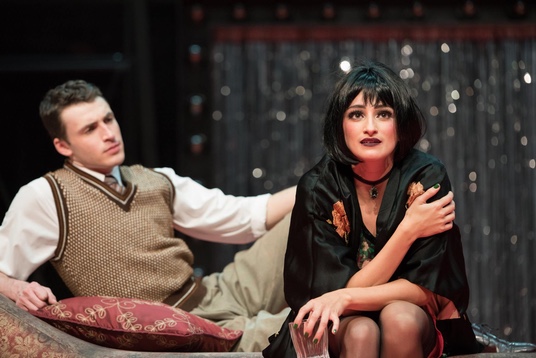Through Sun 11/18
Dead silence at the end of a musical? That’s a big YES!
First-night audiences (November 7 and 8) at Baldwin Wallace’s spectacular Cabaret sat stunned after the affecting first-night performances offered by both the “Sally” and “Cliff” casts. It felt as if it were inappropriate to cheer at the bitter ending of John Kander and Fred Ebb’s Cabaret. Director Victoria Bussert translated the title song that proclaims “Life is a Cabaret” into a beautiful and bitter truth.
The plot of this 1966 musical (based on the 1951 play I Am A Camera by John Van Druten spun off Christopher Isherwood’s Goodbye to Berlin) differs slightly from that adapted for the film starring Liza Minnelli, which softens (a bit) this tale of life in 1931 Berlin. Bussert’s fierce version of the original musical softens nothing.
The story opens when Hitler is beginning his rise to power, but the amusing and risque antitics of the entertainers in Berlin’s Kit Kat Klub distract us from that fact. At least at first. The Emcee’s frenetic “Willkommen,” punctuated by sexually suggestive gestures, made us suspect the Kit Kat Klub wasn’t for children. When the gorgeous ladies sashayed from behind the sparkly string fringe curtain, we were sure.
As the Emcee, both Charlie Ray and Nick Drake radiated gorgeous charm, but the story’s cruelty and pain was not obscured. Despite embracing giddy joy in the opening scenes, Ray movingly revealed the Emcee’s final disintegration in the poignant and real “I Don’t Care Much.” A nimble dancer (as well as a beautiful one), an equally effective Emcee, Drake produced bitter laughs when he and a “monkey” dancingly mocked love (and racial prejudice) in “If You Could See Her.”
Sally Bowles, star of the Kit Kat Klub, turns out to have many dramatic realizations as both Sallys proved. Nadina Hassan brought out the singer’s glamourous yet neurotic persona. And on the next night, Shelby Griswold showed Sally as bouncy, full of vibrant life and, at the same time, one suffering from frenetic despair. Both Hassan and Griswold made Sally someone easy to like, dislike and fear for all at the same time — in other words, an ordinary human, except for her ability to belt out “Don’t Tell Mama” and wail “Cabaret.”
Zach Landes and Enrique Miguel also shared a major role as Cliff, Sally’s boyfriend. Both actors, again created quite different Cliffs — maybe partly in response to different Sallys. The first night, Landes seemed a shy writer just trying to catch up with events, more comfortable behind his typewriter (think Woody Allen); the next evening Miguel played the writer as glamour boy, one used to parties and socializing with “important” people (think F. Scott Fitzgerald).
A touching and tuneful Erin Niebuhr, who played Fraulein Schneider both nights, first brought joy when she and Herr Schultz fell in love (“It Couldn’t Please Me More”) and grief when she admitted she was a survivor, not a martyr (“What Would You Do”).
Herr Schultz, a careful Jew who insisted he’d be all right since he was also German-born, was played as likeable if naive by Sam Columbus. The other Schultz, deep-voiced Marcus Martin, brought a sense of irony to the role (Martin is African-American, Columbus is not) that forced considerations about who might be in a similar situation in America today.
Other outstanding members of the cast included Eric Graupensperger as the seemingly affable German businessman Max and Willem Sandercox as his loyal friend, Ernst. It’s Ernst whose “Tomorrow Belongs to Me” (sung with Emmy Brett’s scheming Fraulein Kost) that provides a chilling end to the first act. It’s not “Edelweiss,” thought it starts out in a similar cheerful, nature-loving manner and pretends to be a song for children.
Ten Kit Kat Girls and ten Kit Kat boys showed spunk and highly disciplined dance moves as part of the club’s entertainment. Choreographer Gregory Daniels and the dancers really do put on quite a cabaret show for us — and yes, it’s naughty and nice all at once.
Well-designed costumes by Tesia Dugan Benson added to our sense of place and history. Perched on a balcony above the stage, conductor Beth Burrier led a small ensemble which provided cool music (and a few atmospheric riffs on its own). The set designed by Charlotte M. Yetman featured stairs up to the band allowing the action to swirl and twirl around and around–perhaps mimicking the chaos in the “real world” below them.
BOTTOM LINE: This stunning Cabaret offers a powerful metaphor. Of what? You get to decide. And even if it doesn’t provoke deep thoughts (and I argue that it does) it’s an electric “don’t miss” show beautifully done. Life may indeed be a cabaret.
